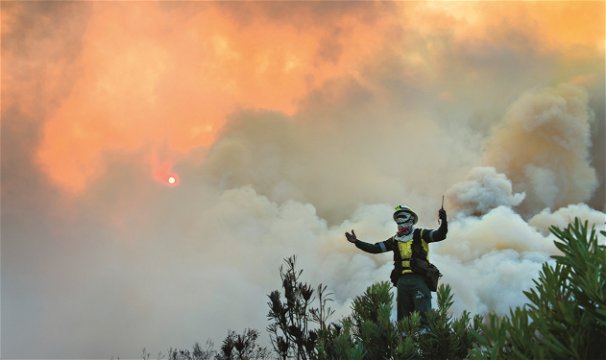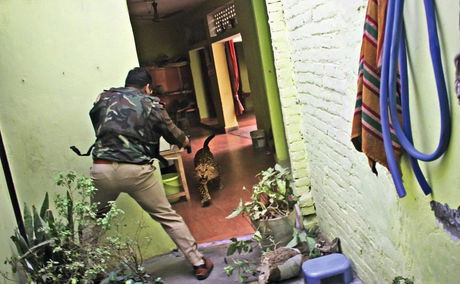TITLE: I could hear leopard crying in pain after it was shot CATEGORY: Stenin Press Photo Contest: TOP NEWS 3rd Place PHOTOJOURNALIST Ajay Kumar received an early morning call to say a wild leopard had been spotted near houses in Lucknow, India. When he arrived at the scene, he followed a crowd of people, including police officers, who chased the animal until it was cornered in a house. When a police officer...
Justin Sullivan Photography
Being shot with rubber bullets during a protest. Sleeping high up in the mountain to photograph fires. These are some of the experiences that helped Cape Town-based photographer Justin Sullivan, 27, to win two awards in the prestigious 2018 Andrei Stenin International Press Photo Contest.
Altogether 67 images of the competition's 22 award-winners are on the Stenin Press Photo Exhibition at the Chavonnes Battery Museum at the Waterfront until February. They were chosen from 6 000 entrants.
Sullivan's image of a policeman who shot a boy during a Hout Bay protest in September, 2017, called Stand Off, won first prize in the hard news category. And his series of pictures depicting the heroes combating wildfires was placed second in the Planet category. "It's really amazing. I was very excited when I heard. It's the first time I'm recognized on an international platform," the photographer said.
Few people know that Sullivan himself got shot with rubber bullets while photographing the boy who got shot with a rubber bullet. "I got hit once in the back when I ran away. Then I sat down and got shot twice in the leg," he said. Sullivan's picture shows the policeman pointing his gun at the boy's face moments after shooting the boy, 14, hitting him in the tongue, while the child was hiding under a table during a protest over fishing rights.
The incident caused widespread condemnation of police brutality. But the photographer is careful not to judge the police officers. "It's an important debate: Yes, police are accused of using excessive force. But why is the child in the protest? Why do we as adults allow that?
"Police were trying to disperse a crowd and people were hiding under tables to launch an attack on them. He would never have shot if he knew there was a child under the table," the photographer said.
His true passion is fires. Sullivan said he started his professional career three years ago during major fires that roared across the South Peninsula in Cape Town in March, 2015, which, at times, saw him "running around in the vineyards of Constantia".
"I posted pictures on Facebook and it went semi-viral. I saw the powerful impact these pictures have, helping to conserve nature and leading to so much praise for the firefighters".
What makes his pictures unusual is he's at the heart of the fires operating alongside the fire crews and sometimes positioned only meters away from the flames. This is demonstrated in his picture of a huge fire in Imizamo Yethu in Hout Bay in March, 2017, when about 2 500 shacks burnt down. It's a close shot of a fireman with an empty hose when the water ran out while shacks burn behind him.
On that day, Sullivan was confronted with the moral dilemma of whether to support victims of a tragedy or document the tragedy. "Do you help? Or take a picture?" he asked.
As the shacks burnt to the ground in front of him, he chose to help more and take fewer pictures.
"That was the hardest day of my life," the photographer reflects. Sullivan spent nearly five hours at the fire, mostly helping people move their belongings out of shacks before they became engulfed in flames. In all that time, he shot 50 frames only. Yet those pictures provided an inside view without which "people might not have known the extent of that fire and what it was really like," he said.
Fires in informal settlements are especially difficult to contain, said Sullivan. "Not only is there a lack of water, but the spaces in between the shacks are too narrow as well, the shacks are too close together," he said.
The reason why he's got such good access is because of years of building relationships with firefighters and undergoing wildfire training up to the level of crew leader. This means Sullivan has become used to spending nights on the mountain, sometimes sleeping on the top of the mountain like the other firefighters. "You cut a bush down and use it as a blanket," the photographer said. He acknowledges how dangerous it is and that he's exposed to "exactly what the firemen are going through. I've done the training so that I can be just as clued".
Sullivan is a volunteer who has offered most of his pictures for free, whether to media organizations, local government or companies. His reward is to raise awareness of fires and encourage more support for firefighters. Sullivan funds his fire assignments with money he makes from corporate work, including events photography. He recently travelled to Namibia, Botswana and the Kruger National Park on behalf of various companies.
The graduate in Development & Environmental Studies from the University of Stellenbosch, who was born in Eshowe, KZN, is currently working on a 45-minute long educational documentary entitled Walking With Fire. Filming will take place over the next three months, mostly in Cape Town and George.
"I enjoy being in nature and I have developed such a love for photography," he said.
For Sullivan, covering wildfires across the world is an important goal for the future. Next year, he plans to go to California and for 2020 he's set his sights on Australia. Justin Sullivan Webpage CLICK HERE
The Andrei Stenin International Press Photo contest was established on December 22, 2014. The contest is run by Rossiya Segodnya under the auspices of the Russian Federation Commission for UNESCO. It is an annual contest for young photojournalists aged between 18 and 33 years old. It is Russia’s only platform for discovering new photojournalists and for allowing them to make a name for themselves on the world photojournalism stage.
Further Reading
Jenny Stromvoll was awarded WINNER of the Compact Camera Category in the 2017 Underwater Photographer of the Year competition. Her image, ‘I’ve got my eye on you’, was taken in Mozambican waters with a Cannon camera. She recently visited the Underwater Photographer competition photo exhibition at the Chavonnes Battery in Cape Town to view her handiwork.
A photo by Simon Norfolk depicts a gate at the U.S.-Mexican border. In this night-time image, Norfolk captured the flight of moths in neon light, their trajectory resembling twisted strands of wire. “And what is the light?” Little wonders. “Is it what we think it is? I don’t think the light is even what Americans think it is, not to mention people from impoverished regions in Central America. I think we’re all...










Share This Post